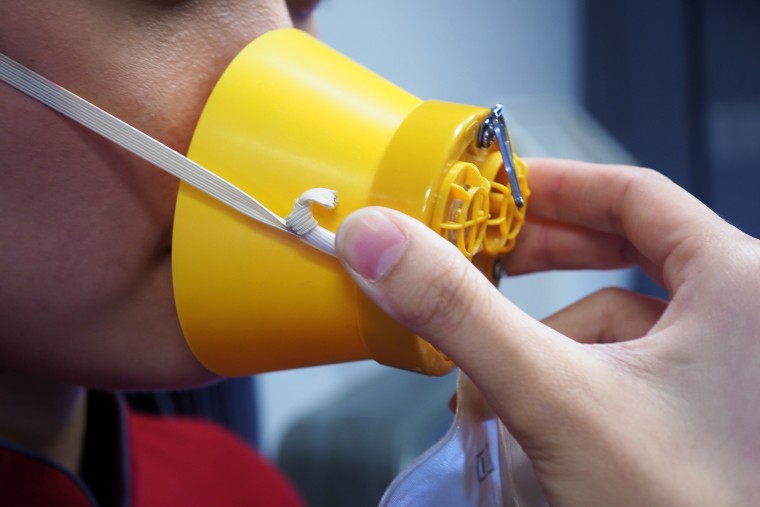Passengers on Southwest Airlines Flight 1380 faced 20 minutes of terror on Tuesday when the engine exploded, shrapnel blew out a window and the airplane cabin quickly depressurized. Safety measures kicked in, and oxygen masks dropped from the ceiling as pilot Tammie Jo Shults was forced to make an emergency landing in Philadelphia.
One big problem? Many of those on board weren’t wearing their masks correctly.
Bobby Laurie, a former flight attendant and co-host of “The Jet Set,” shared a passenger's photo on Twitter pointing out the serious safety mishap. "PEOPLE: Listen to your flight attendants!" he wrote. "ALMOST EVERYONE in this photo from @SouthwestAir #SWA1380 today is wearing their mask WRONG."
While others commented on the photo that the positioning of the masks didn't matter since almost everyone made it off safely (though one passenger died), Laurie told TODAY it’s extremely important.
“You could come down with hypoxia if you don’t have your oxygen mask on correctly,” he said. “That could lead to you passing out, getting blurred vision and your judgment is slowed, so you’re unable to make decisions in an emergency. That’s why flight attendants show you how to put on the mask, it’s written in the safety card and it’s on the bag itself.”
Know the right way to wear an airplane oxygen mask.

Many in the photo had the mask over their mouths, but it should cover both nose and mouth. Otherwise, “it's like snorkeling in the sky,” said Laurie. “You'd have to remember to breathe out of your mouth consciously.”
Others commented that the design of the mask is flawed, and it wouldn’t fit over some passengers’ noses and mouths. Laurie disagrees. “It doesn't look like it would actually cover nose and mouth, but it's not solid plastic,” he said. “You could squeeze the mask to elongate. That's why the flight attendants ask you to tighten the straps on the mask so it conforms to your face.”
And improperly wearing oxygen masks isn’t the only common mistake passengers make despite there being an extensive safety briefing on every flight.
'We only have 90 seconds to get every passenger off the plane.'
“Passengers try to fit large luggage under the seat even though we require they go in an overhead bin,” New York-based flight attendant Eric Foy told TODAY. “The reason why we tell you that is because it could block someone’s way out in an emergency. We only have 90 seconds to get every passenger off the plane no matter the size of the plane.”
Laurie added: “When I was a flight attendant, every time I took out the evacuation slide some passengers would bring their luggage even though we stipulate to leave everything behind. Bags are not made for emergency evacuations. Those slides are like big balloons and the luggage can puncture that slide leaving other people stranded on the plane or having to jump.”
Buckle up even when the seat belt sign isn't on.
Not securely fastening your seat belt is another major misstep. Sure, you might laugh at the safety video showing you how to buckle up, but not doing it properly can lead to serious injuries.
“Seat belts need to be worn low and tight across your lap,” said Foy. “Even though I’m a flight attendant, when I’m a passenger, I still tighten my seat belt a little extra during takeoff just for the reassurance. Turbulence is very unpredictable, and you can get very injured. Trust me; I got thrown against a bin once.”
Laurie agrees with the seat belt reminder. “The seat belt sign might be turned off, but we recommended to keep it on for a reason,” he said. “No one expected the engine to explode on that Southwest flight and you can even get injured from turbulence.”
Both Laurie and Foy acknowledge it’s easy to become complacent since most flights are uneventful. But flight attendants give safety instructions in case something does go wrong, and they want you to be prepared.
“We hope they care enough to listen because if there is an emergency you might panic, and that won’t help you or anyone,” said Foy. “At the end of the day, I’m human. I have friends and a family that love me and that want me to be safe, just like you.”